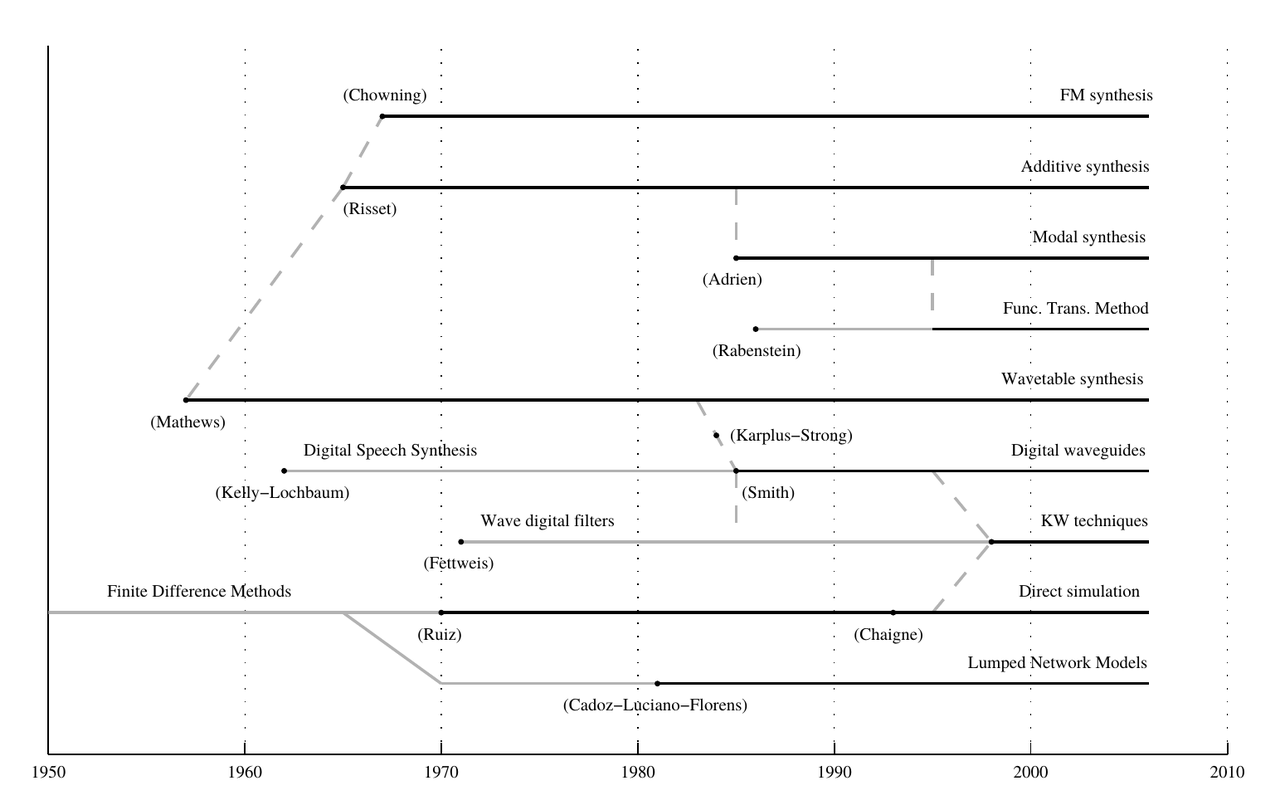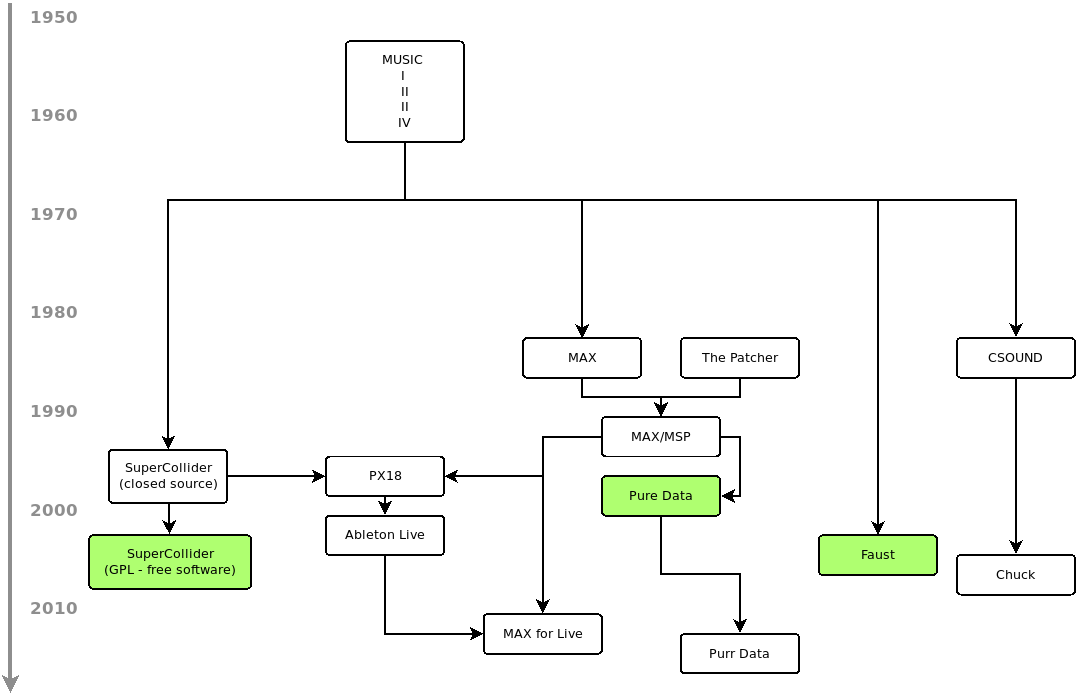A Brief History
Beginnings of Computer Music
First experiments on digital sound creation took place 1951 in Australia, on the CSIRAC computer system. Besides from these experiments, the development of digital sound synthesis dates back to the first experiments of Max Mathews at Bell Labs in the mid 1950s. Mathews created the MUSIC I programming language for generating musical sounds through synthesis of a single triangular waveform on an IBM 704. The Silver Scale, realized by psychologist Newman Guttman in 1957, is one of the first ever digitally synthesized piece of music (Roads, 1980).
MUSIC and its versions (I, II, III, ...) are direct or indirect ancestors to most recent languages for sound processing. Mathews defined the building blocks for digital sound synthesis and processing in these frameworks (Mathews, 1969, p. 48). This concept of unit generators is still used today. Although the first experiments sound amusing from today's perspective, he already anticipated the potential of the computer as a musical instrument:
“There are no theoretical limitations to the performance of the computer as a source of musical sounds, in contrast to the performance of ordinary instruments.” (Mathews, 1963)
Mathews created the first digital musical pieces himself, but in order to fully explore the musical potential, he was joined by composers, artists and other researchers, such as Newman Guttman, James Tenney and Jean Claude Risset. Risset contributed to the development of electronic music by exploring the possibilities of spectral analysis-resynthesis (1:20) and psychoacoustic phenomena like the Shepard tone (4:43):
Later, the Bell Labs were visited by many renowned composers of various styles genres, including John Cage, Edgard Varèse and Laurie Spiegel (Park, 2009). The work at Bell Labs will be in focus again in the section on additive synthesis.
A Pedigree
The synthesis experiments at Bell Labs are the origin of most music programming languages and methods for digital sound synthesis. On different branches, techniques developed from that seed (Bilbao, 2009):

The following family tree focuses on the tools used in this class and is thus without any claim to completeness:

Chowning & CCRMA
The foundation for many further developments was laid when John Chowning brought the software MUSIC VI to Stanford from a visit at Bell Labs in the 1060s. After migrating it to a PDP-6 computer, Chowning worked on his groundbreaking digital compositions, such as Turenas (1972), using the frequency modulation synthesis (FM) and spatial techniques. Although in particular known for discovering the FM synthesis, these works are far more than mere studies of technical means:
Puckette & IRCAM
Most of the active music programming environments, such as Puredata, Max/MSP, SuperCollider or CSound, are descendants of the MUSIC languages. Graphical programming languages like Max/MSP and Puredata were actually born as patching and mapping environments. Their common ancestor, the Patcher (Puckette, 1986; Puckette, 1988), developed by Miller Puckette at IRCAM in the 1980s, was a graphical environment for connecting MAX real-time processes and for controlling MIDI instruments.
The new means of programming and the increase in computational power allowed musique mixte with digital signal processing means. Pluton (1988-89) by Philippe Manoury is one of the first pieces to use MAX for processing piano sounds in real time (6:00-8:30):
Links
120 Years of Electronic Music is a very thorough site on history and development of electronic musical instruments.
A talk by Paul Davis (Jack, Ardour) on the development of open source audio:
References
2011
- John Chowning.
Turenas: the realization of a dream.
Proc. of the 17es Journées d’Informatique Musicale, Saint-Etienne, France, 2011.
[details] [BibTeX▼]
2009
-
Bilbao, Stefan.
Numerical Sound Synthesis.
Wiley Online Library, 2009.
ISBN 9780470749012.
doi:10.1002/9780470749012.
[details] [BibTeX▼] - Ananya Misra and Perry R Cook.
Toward Synthesized Environments: A Survey of Analysis and Synthesis Methods for Sound Designers and Composers.
In Proceedings of the International Computer Music Conference (ICMC 2009). 2009.
[details] [BibTeX▼] - Tae Hong Park.
An interview with max mathews.
Computer Music Journal, 33(3):9–22, 2009.
[details] [BibTeX▼]
1991
- Julius O. Smith.
Viewpoints on the History of Digital Synthesis.
In Proceedings of the International Computer Music Conference, 1–10. 1991.
[details] [BibTeX▼]
1988
- Miller S. Puckette.
The patcher.
In Proceedings of the International Computer Music Conference (ICMC). 1988.
[details] [BibTeX▼]
1986
- Emmanuel Favreau, Michel Fingerhut, Olivier Koechlin, Patrick Potacsek, Miller S. Puckette, and Robert Rowe.
Software developments for the 4x real-time system.
In Proceedings of the International Computer Music Conference (ICMC). 1986.
[details] [BibTeX▼]
1980
- Curtis Roads and Max Mathews.
Interview with max mathews.
Computer Music Journal, 4(4):15–22, 1980.
[details] [BibTeX▼]
1969
1963
- Max V Mathews.
The Digital Computer as a Musical Instrument.
Science, 142(3592):553–557, 1963.
[details] [BibTeX▼]
